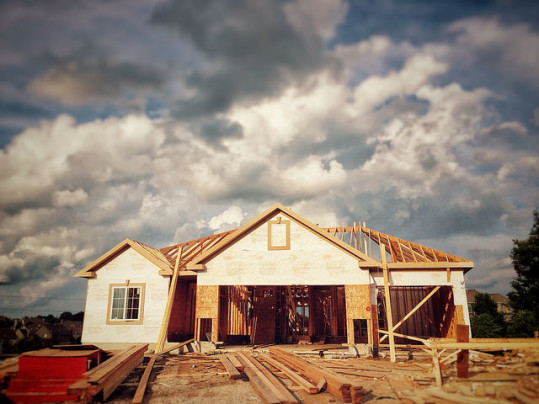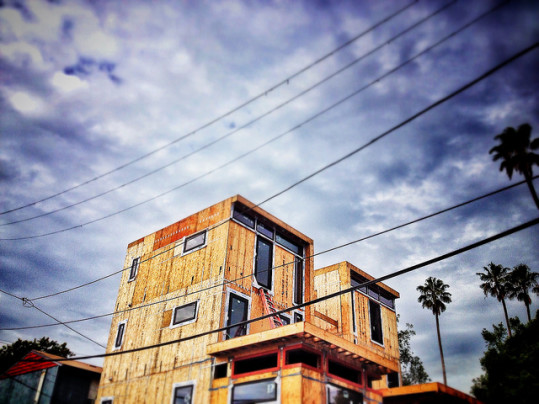The new home market is an important indicator for anyone interested in making a move in the near future. Mostly, this is because the number of new homes being built and put on the market has an affect on home prices across the board. And so, keeping an eye on how confident builders feel can be a good way of gauging upcoming affordability conditions. For this reason, the National Association of Home Builders conducts a monthly survey of builders and scores their perceptions on a scale where any number above 50 indicates more of them view conditions as good than poor. In September, their Housing Market Index was unchanged from the month before but still high at 67. Randy Noel, NAHB’s chairman, says builders are feeling optimistic due to a high level of demand and lower lumber prices. “Despite rising affordability concerns, builders continue to report firm demand for housing, especially as millennials and other newcomers enter the market,” Noel said. “The recent decline in lumber prices from record-high levels earlier this summer is also welcome relief, although builders still need to manage construction costs to keep homes competitively priced.” More here.
Archive for September 2018
Young Americans Choose The City Over Suburbs
When choosing where you’d like to live, there are a number of factors that you have to weigh. For example, some people may value privacy over convenience while others may prefer proximity to family and friends over entertainment and recreation options. In short, it’s a personal choice. And a lot of times it comes down to whether you’d like to live in a city setting or the suburbs. This is a common debate and one that typically falls along demographic lines. In other words, where you are in life will determine where you want to live. More proof of this is found in a recent report detailing the preferences of millennials. According to the results, young Americans overwhelming choose metropolitan areas known for their hip neighborhoods and closeness to job opportunities. In fact, a look at the top 10 zip codes with the largest population of millennials shows that areas like Chicago’s West Loop, Boston’s North End, and Manhattan’s Financial District are overwhelmingly popular with a younger demographic. Other city neighborhoods that make the list include Capitol Hill in Denver, Mission Bay in San Francisco, and Dallas’ Arts District. More here.
Today’s Home Buyers Likely To Find Financing First
Buying a home is not something most people do very often. Unless you’re a real-estate investor or have to move frequently for work, you’re likely going to stay in the home you buy for more than a couple of years. In fact, recent data shows homeowners tend to stay in their house somewhere between 10 and 13 years. So it shouldn’t be surprising that there are some common misconceptions about the buying process and the best way to go about finding and buying a house. But, according to a recent survey, one common misstep is becoming less and less common. That’s because, the survey found nearly two thirds of recent buyers looked for financing before looking at homes and, among first-time buyers the number jumped to 85 percent. This is the right way to do things for a couple of reasons. First, meeting with a mortgage professional before heading out on the trail will let you know exactly where your price range is and what you may be qualified to borrow. Secondly, in a competitive market, having your financing already lined up means you can act fast when you find a home you love. If you’re not prequalified, a more prepared buyer is likely to make an offer and have the home under contract before you’ve even completed your application. More here.
Housing Forecast Has Good News For Buyers
In large part, home prices are a simple calculation of supply and demand. When there are more homes than interested buyers, home prices fall. When the opposite is true, home prices rise. In recent years, demand from potential home buyers has risen and the number of available homes for sale has not, which is why prices have gone up. To some extent, that’s because builders have been building fewer new homes. There are a number of reasons for this, including the recession that followed the financial crisis, rising labor and material costs, and a lack of available lots to build on. But, since building more homes is the fastest way to improve inventory levels and moderate price increases, this has caused affordability conditions to suffer and made finding a home to buy challenging for buyers in some markets. But a recent forecast from Freedonia Focus Reports may be good news for Americans interested in buying a home in the near future. According to the forecast, the number of new homes built will grow 2.4 percent annually through 2022 due to “rising levels of employment and strengthening consumer finances.” If true, that should help slow increasing prices and bring more choices for buyers of both new and existing homes. More here.
Stronger Economy Continues To Drive Mortgage Rates
Mortgage rates, to some extent, are reactionary. And so, as the economy grows stronger, rates increase. That’s been the story so far this year and, according to the latest results from the Mortgage Bankers Association’s Weekly Applications Survey, last week was no exception. That’s because, rates were up across all loan categories, including 30-year fixed-rate mortgages with both conforming and jumbo balances, loans backed by the Federal Housing Administration, and 15-year fixed-rate loans. Joel Kan, MBA’s associate vice president of economic and industry forecasting, told CNBC the increase was a response to improved economic data. “Treasury rates increased through the week, mainly in response to stronger data on the manufacturing sector, unemployment claims and signs of faster wage growth,” Kan said. In other words, the economy is stronger, people feel more secure in their jobs and are making more money, which caused rates to move to a five-week high. But, though mortgage rates moved up, they are still low when compared to what is historically typical and demand from home buyers remains undeterred. In fact, though affordability concerns persist, the MBA’s measure of demand for home purchase loans moved up last week and is now four percent higher than at the same time last year. More here.
Few Buyers Research Their Prospective Neighborhood
Choosing a house to buy is an important decision. After all, you’re committing a lot of money and several years of your life to a particular property. And so, home buyers tend to know what they want, whether it be a large kitchen, an appealing outdoor space, or an ample amount of storage. But surprisingly, large majorities of home buyers spend too little time paying attention to the neighborhood surrounding the home they’re considering. And, make no mistake, the neighborhood you move to will play an important role in how much you enjoy your new home. Surrounding amenities, schools, and safety are just a few of the factors that can lead to a case of buyer’s remorse. And, according to a recent survey, there are lot of buyers who’ve experienced just that. In fact, 36 percent of respondents said they’d have chosen a different neighborhood had they known more about the one they moved to. One reason this is so common is the number of buyers who do very little neighborhood research before buying. For example, less than half of recent home buyers searched photos of different parts of the neighborhood, visited hot spots, researched police reports, or took a trip to the area after dark. If you want to be certain you’re making a smart choice, do your homework and consider the area outside your potential new house just as much as you do the inside. More here.
Is Debt Holding Millennial Buyers Back?
These days, just about everyone has some debt. It’s almost more remarkable not to carry a balance of one type or another. In fact, a report last year found that 73 percent of consumers died with unpaid debts and, among them, the average owed was $62,000. That’s a lot. But accruing debt over a lifetime is different than starting one already in the hole. And, unfortunately, many young Americans today find themselves in that situation. For the most part, student loans are responsible for the money millennials owe, but credit cards and auto loans can also add to the mix. And, unsurprisingly, this is a factor when it comes time to decide whether or not to buy a house. But just how much debt are potential first-time home buyers facing? Well, according to a new study, in the top 10 cities where millennials owe the most, half of them have an outstanding balance of $25,000 or more, while about 25 percent of them owe more than $50,000. To what extent this has caused fewer young Americans to pursue homeownership, it’s hard to know. However, having some debt won’t necessarily prevent you from buying a house. And, since there are many financial factors at play, you won’t know for sure whether you might qualify for a home loan until you sit down with a mortgage professional and go over your numbers. More here.







